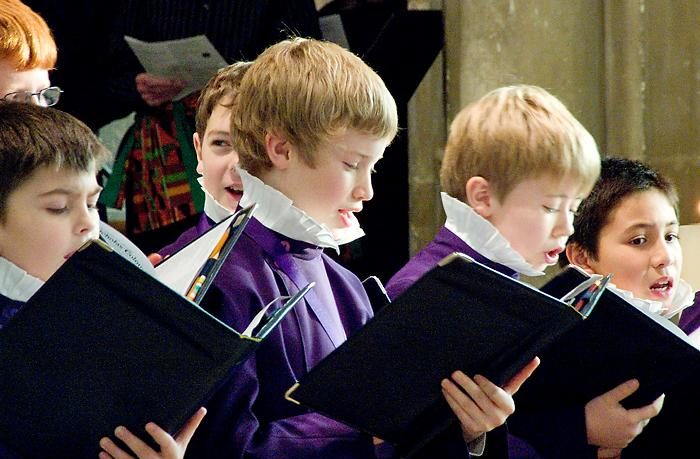At 3pm on Christmas Eve, millions of radios around the world will be tuned to the Festival of Nine Lessons and Carols from King’s College Chapel in Cambridge in time to hear the pure voice of a single boy chorister singing one of the hardest solos of the church calendar, the first verse of “Once in Royal David’s City”.
For many, this signals the start of Christmas. Broadcasts of the Christmas Eve service from King’s began in 1928, but arguably it was under the guidance of Sir David Willcocks, who died in September 2015, aged 95, that the service – and the choir – became household names.
Once in Royal David’s City.
The many tributes that followed Willcocks’ death all acknowledged that during his tenure from 1957 to 1973, his name became virtually synonymous with the idea of a traditional Christmas Carol service. The Nine Lessons and Carols form became popular in churches and chapels of all sizes and traditions, and is still widely used today.
The King’s model and the influence of the Carols for Choirs series – a series of books edited by Willcocks, first with Reginald Jacques and later John Rutter – have together had a huge effect on the way in which millions of people think about Christmas music.

David Willcocks edited a series of carol books which have become standards.
The link between Willcocks’ association with King’s and his work as composer, arranger and editor for the Carols for Choirs series is significant. For church musicians, using the familiar green and orange volumes creates a connection between their own efforts – no matter how modest the scale – and the internationally famous broadcast.
Rather than the perfect singing and sublime organ playing seeming impossibly remote, access to the books – which contain many of the same pieces and arrangements – transforms the broadcast into an inspirational experience.
The art of arrangement
Willcocks’ skillful writing for voices and organ is vital in making the connection. Many of his obituaries comment on his ability to inspire the amateur choirs that he conducted. His carol arrangements display the same qualities: demanding, certainly, but achievable thanks to his intimate knowledge of vocal technique and keyboard writing.
His arrangement of “O Come, All Ye Faithful”, probably his most famous, is an excellent example. The setting of the sixth verse responds to the invitation of the words: “Sing, choirs of angels…” with an exuberant descant and rich-textured organ accompaniment. The swirling sequence in the descant on the word “Glory”, borrowed from “Ding Dong, Merrily On High,” achieves a thrilling vocal sound.
The opening of the organ part, calling for the melody to be played on the mighty tuba stop, adds a sense of grandeur, even when played on a small church organ. Later, the sustained rumble of the organ under the words: “O come, let us adore him”, builds anticipation ahead of the verse’s final words: “Christ the Lord”. This verse is rewarding for the congregation, too, for although they continue to sing the same melody as in previous verses, its role is transformed. It becomes part of a vital part of a complex texture, anchoring the whole to the original carol.
Ding Dong Merrily on High (Willcocks)
Willcocks’ approach in the final verse: “Yea, Lord, we greet thee”, traditionally reserved until Christmas Day, is very different. Most strikingly, all voices sing the melody together. All of the drama and excitement is packed into the organ part. The bold opening unison accompaniment stresses the unity of everyone participating.
The climax arrives on “Word”, with a daringly dissonant chord providing the perfect musical accompaniment to the textual reference to the divine mystery described in the Prologue to St John’s Gospel. For the congregation, singing this note harmonised in such a way is a radically different experience from the earlier verses. Its effect is exhilarating, and is made all the more so because it is shared by every singer, not just the highly skilled choristers.
Willcocks’ legacy
The writing of these arrangements is but one example of Willcocks’ musical genius. Others have rightly praised his landmark recordings of works such as Fauré’s Requiem, his contributions as conductor of the Bach Choir and director of the Royal College of Music – and his devotion to the highest musical standards on a daily basis at King’s. However, for most who knew his name, it is his contribution to Christmas music that stands out.
For countless choristers, his descants, learned as children, are etched into their musical memory. For congregation members, including those who perhaps only attend church once a year, they create a sense of participation in the wonder and mystery of Christmas. For the worldwide radio and television audiences, they play a crucial role in the association of King’s with a traditional Christmas experience.
The popularity and durability of the arrangements, many of which have been in print for more than 50 years, has already been established. This first Christmas holiday after David Willcocks’ death offers a fitting opportunity to acknowledge his supreme musical skill and to invite choristers, organists and congregations to appreciate his work afresh.
![]()
Written by Martin Clarke, Lecturer in Music, The Open University
This article was originally published on The Conversation. Read the original article.
Photo by chrisjohnbeckett 



